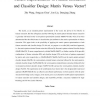151
Voted
TSMC
2008
14 years 11 months ago
2008
Abstract-- Using the kernel trick idea and the kernels as features idea, we can construct two kinds of nonlinear feature spaces, where linear feature extraction algorithms can be e...
112
Voted
PRL
2007
15 years 2 days ago
2007
We used the datasets of the NIPS 2003 challenge on feature selection as part of the practical work of an undergraduate course on feature extraction. The students were provided wit...
124
Voted
PRL
2007
15 years 2 days ago
2007
Two-dimensional principal component analysis (2DPCA) is based on the 2D images rather than 1D vectorized images like PCA, which is a classical feature extraction technique in face...
104
Voted
TNN
1998
15 years 7 days ago
1998
— This paper introduces a new system for real-time detection and classification of arbitrarily scattered surface-laid mines from multispectral imagery data of a minefield. The ...
89
Voted
IJON
2007
15 years 11 days ago
2007
Kernel principal component analysis (KPCA) extracts features of samples with an efficiency in inverse proportion to the size of the training sample set. In this paper, we develop...
118
click to vote
UAIS
2008
15 years 14 days ago
2008
Abstract Research in the field of sign language recognition has made significant advances in recent years. The present achievements provide the basis for future applications with t...
116
Voted
TSMC
2008
15 years 14 days ago
2008
In this paper, we present an extensive study of 3-D face recognition algorithms and examine the benefits of various score-, rank-, and decision-level fusion rules. We investigate f...
103
click to vote
TNN
2008
15 years 14 days ago
2008
The matrix, as an extended pattern representation to the vector, has proven to be effective in feature extraction. But the subsequent classifier following the matrix-pattern-orien...
109
Voted
SCN
2008
Springer
15 years 15 days ago
2008
Springer
Abstract-- Despite the rapid advance in networking technologies, detection of network anomalies at high-speed switches/routers is still far from maturity. To push the frontier, two...
81
Voted
PAMI
2008
15 years 16 days ago
2008
Beyond conventional linear and kernel-based feature extraction, we present a more generalized formulation for feature extraction in this paper. Two representative algorithms using ...


